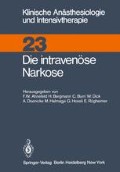Zusammenfassung
Das potente Kataleptanalgetikum Ketamin entfaltet seine narkotisch -kataleptische Wirkung durch eine Koordinationsunterbrechung (Dissoziation) zwischen neokortikal-thalamischen und limbisch-retikulären Hirnstrukturen. Die resultierende „Katalepsie“ ist durch Bewu ßtlosigkeit, Reaktionsverlust und Deafferentierungsrigidität gekennzeichnet. Das thalamokortikale Projektionssystem scheint dabei deutlicher inhibiert zu sein, während im Bereich des diffusen retikulären und limbischen Systems inhibitorische und exzitatorische Effekte nebeneinander auftreten. Diese zentralen, für Ketamin spezifischen Angriffspunkte erklären sein besonderes Wirkungsspektrum: kardiozirkulatorische Stimulation mit vermehrter Organdurchblutung, erhaltene zirkulatorisch-homöostatische Regulation, gesteigerte Salivation, gesteigerter Muskeltonus und Eigenreflexe, geringe Depression protektiver Reflexe, Atemrhythmusveränderungen bei fehlender zentraler Atemdepression.
Access this chapter
Tax calculation will be finalised at checkout
Purchases are for personal use only
Preview
Unable to display preview. Download preview PDF.
Literatur
Agoston, S., V. Weerden, T., Westra, P., Broekert, A.: Effects of 4-AP in Eaton Lambert syndrom. Brit. J. Anaesth. 50, 383 (1978).
Agoston, S., Salt, P., Erdmann, W., Hilkemeyer, T., Bencini, A., Langrehr, D.: Antagonism of Ketamine-Diazepam anesthesia by 4-AP in human volunteers. Brit. J. Anaesth. 52, 367 (1980).
Benke, A., Balogh, A., Reich-Hilscher, B.: Über die atmungsspezifische Wirkung des Lösungsvermittlers von Diazepam (Valium). Anaesthesist 28, 24 (1979).
Brown, C., Sarnquist, F., Canup, C., Pedley, T.: Clinical, electroencephalographic and pharmacokinetic studies of Midazolam. Anesthesiology 50, 467 (1979).
Crevoisier, Ch.: Aspects pharmacocinetiques du Midazelam. Arzneimittel-Forsch. (Im Druck).
Doenicke, A., Kugler, A.: Beeinflussung des ZNS durch Midazolam und Dosisfindung. Arzneimittel-Forsch. (Im Druck).
Drummond, J. C., Brebner, J., Galloon, S., Young, P.: A randomized evaluation of the Ketamine reversal by physostigmine. Canad. Anaesth. Soc. J. 26, 288 (1979).
Dundee, J. W., Samuel, I. O., Turner, W., Howard, P. J.: Midazolam: a water soluble benzodiazepine. Anaesthesia 35, 454 (1980).
Folgering, H., Rutten, J., Agoston, S.: Stimulation of phrenic nerve activity by 4-AP. Pflügers Arch. 379, 181 (1979).
Kitahata, L. M., Taub, A., Kosada, Y.: Lamina-specific suppression of dorsal-horn unit activity by Ketamine hydrochloride. Anesthesiology 38, 4 (1973).
Kubicki, St. K., Neuhaus, G. A.: Pentazocin-ein neuer Weg. Stuttgart: Thieme 1975.
Langrehr, D., Erdmann, W.: Kardiozirkulatorische und respiratorische Wirkung der Kombination von Midazolam und Ketamine. Arzneimittel-Forsch. (Im Druck).
Lundh, H.: Effects of 4-AP on neuromuscular transmission. Brain Res. 153, 307 (1978).
Martinez-Aguirre, E., Crul, J.: Effect of TEA and 4-AP on recovery from Diazepam-Ketamine anesthesia in the monkey. Acta anaesth. belg. 30, 231 (1979).
Miller, R., Denissen, P., v. d. Pool, F., Agoston, S., Booij, L., Crul, J.: Potentiation of neostigmine and pyridostigmine by 4-AP in the rat. J. Pharm. Pharmacol. 30, 699 (1980).
Miyasaka, M., Domino, E. F.: Neuronal mechanisms of Ketamine induced anesthesia. Int. J. Neuropharmacol. 7, 557 (1968).
Otani, M., Kikucchi, H., Kitahata, L., Taub, A., Toyooka, H., Hanaoka, K., Dohi, S.: Effects of Ketamine on nociceptive cells in the medial medullary reticular formation of the cat. Anesthesiology 51, 414 (1979).
Pandit, S. K., Kothary, S., Kumar, S.: Low dose intravenous infusion technique with Ketamine. Anaesthesia 35, 669 (1980).
Ryder, S., Way, W., Trevor, A.: Comparative pharmacology of the optical isomers of Ketamine in the mice. Europ. J. Pharmacol. 49, 15 (1978).
Schafer, E., Bruntou, R., Cunningham, D.: A summary of the acute toxicity of 4-AP to birds and mammals. Toxicol. appl. Pharmacol. 26, 532 (1973).
Sia, R., Agoston, S., Salt, P., Erdmann, W., Langrekr, D.: Effects of 4-AP upon postoperative respiratory depression in patients. Acta anaesth. belg. 26, suppl. 195 (1979).
Struppler, A.: Zentralnervöse Verarbeitung und efferente Beeinflussung des Schmerzes. In: Schmerz, p. 125. Stuttgart: Thieme 1972.
Tarnow, J., Hess, W., Schmidt, D., Eberlein, H. J.: Narkoseeinleitung bei Patienten mit koronarer Herzkrankheit: Flunitrazepam, Diazepam, Ketamine, Fentanyl. Anaesthesist 28, 9 (1979).
Vree, T., Baars, A., Booij, L., Driessen, J. J.: Pharmacokinetics of Midazolam. Arzneimittel-Forsch. (Im Druck).
White, P., Ham, J., Way, W., Trevor, A.: Pharmacology of Ketamine isomers in surgical patients. Anesthesiology 52, 231 (1980).
Editor information
Editors and Affiliations
Rights and permissions
Copyright information
© 1981 Springer-Verlag Berlin Heidelberg
About this chapter
Cite this chapter
Langrehr, D.V., Erdmann, W., Newton, D., Agoston, S. (1981). Ketamin, ataranalgetische Kombinationen und Antagonisierung. In: Ahnefeld, F.W., et al. Die intravenöse Narkose. Klinische Anästhesiologie und Intensivtherapie, vol 23. Springer, Berlin, Heidelberg. https://doi.org/10.1007/978-3-642-68192-9_11
Download citation
DOI: https://doi.org/10.1007/978-3-642-68192-9_11
Publisher Name: Springer, Berlin, Heidelberg
Print ISBN: 978-3-540-10953-2
Online ISBN: 978-3-642-68192-9
eBook Packages: Springer Book Archive

